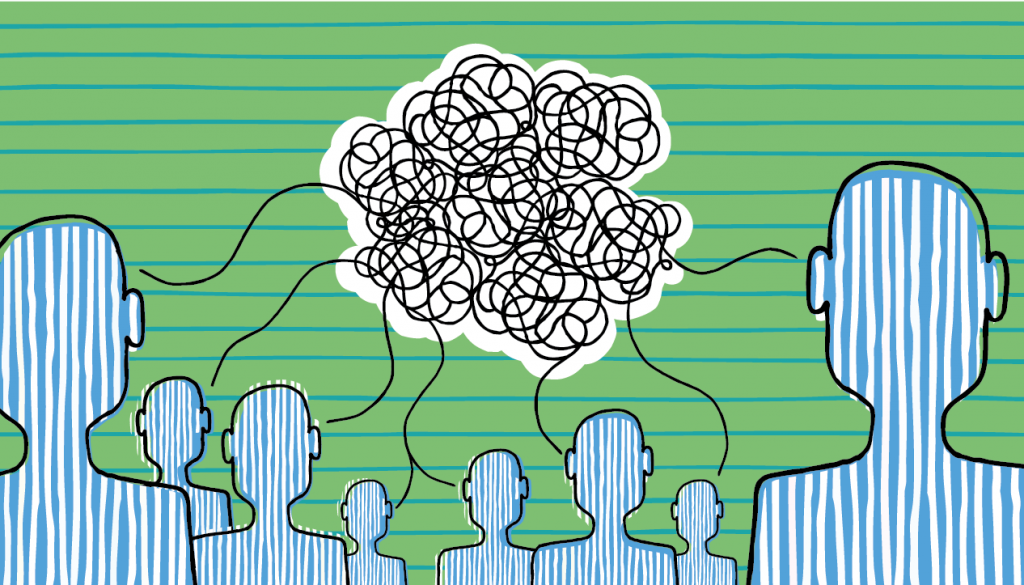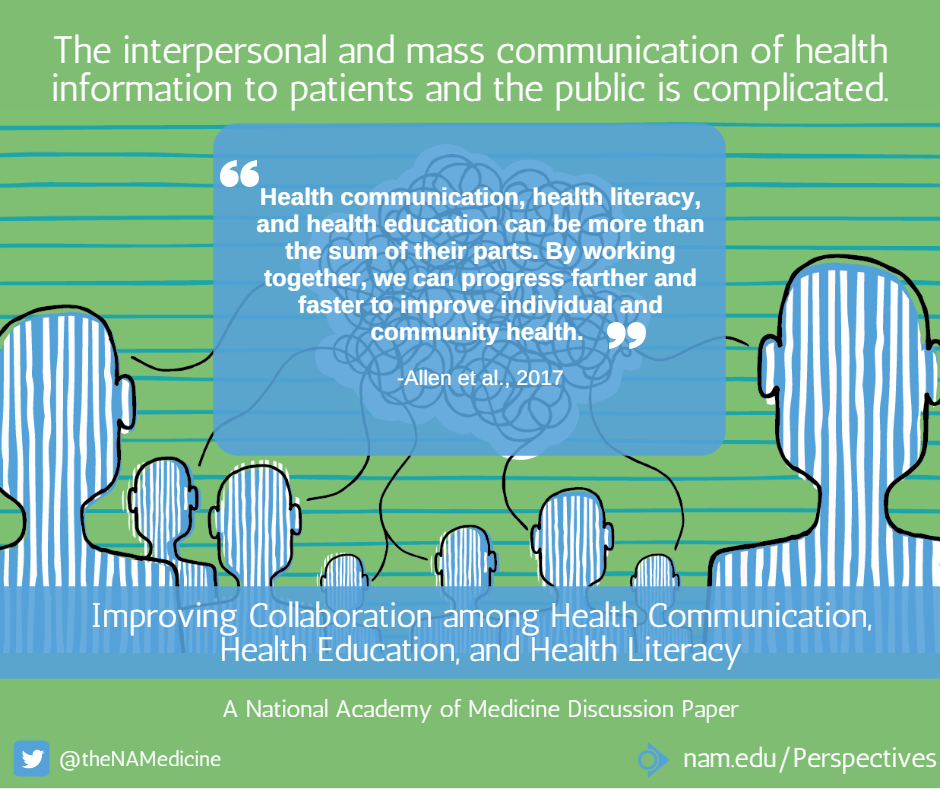Improving Collaboration among Health Communication, Health Education, and Health Literacy

Health communication, health education, and health literacy are rooted in a common understanding of human communication and share the goals of enhancing human health, improving health outcomes, and reducing health disparities. We have an opportunity to mobilize the wisdom, research, and practice of these disciplines to collaborate and foster new research and understanding. Using this perspective, we note the common framework of meaning-centered communication within health communication, health education, and health literacy and suggest it provides a conceptual foundation to advance multidisciplinary understanding and collaboration.
We urge health communication, health education, and health literacy professionals to reach out across the boundaries of their respective disciplines to transform health communication practices and research.
The Conceptual Framework Underlying Health Communication, Health Education, and Health Literacy
Health communication, health literacy, and health education have grown out of knowledge gained from centuries of studying human interaction through observation and research. This knowledge provides the foundation of the philosophy of meaning-centered communication. Meaning-centered communication is communication that is intentional, purposeful, and aware of the perceived context of both the sender of the message and the receiver [1]. The concept of rhetorical communication, defined as “the process of a source stimulating a source-selected meaning in the mind of a receiver by means of verbal and nonverbal messages” is a fundamental building block for our shared understanding [2].
This philosophy provides a framework that appreciates the elements of communication that potentially impact human attitudes, opinions, or practices in diverse settings, including health. It begins with a fundamental recognition of how humans interact, how people are persuaded and perceive risks, and how persons perceive the need for or the ability to change behavior. From the use of complex written, spoken, or signed language to microexpression responses, we intentionally and unintentionally communicate in continuous loops of activity.
Recognizing this shared foundation provides an opportunity for those in the fields of health communication, health literacy, and health education to reconsider how they contribute to the creation of meaning within health communication understood broadly. Such recognition also allows for the consideration of collaboration in future research and practice. Although the three fields have developed separately out of their shared beginnings, there is a growing awareness that they are inextricably linked and can better fulfill their missions by working together. This provides a pathway to progress.
Health Communication
The specific field of health communication evolved to what the National Institutes of Health and the Centers for Disease Control and Prevention have defined as “the study and use of communication strategies to inform and influence individual decisions that enhance health [3].” There also has been a growing understanding of the broader implications of the systems and influences that impact how individuals and groups perceive health.
The interpersonal and mass communication of health information to patients and the public is complicated. For example, despite the presence of an impressive evidence base, professional credentials, and good intentions from the messenger, the public’s response to messages from the scientific community can be one of disinterest or mistrust [4]. Consequently, there must also be an awareness of the context in which messages about health are received. The trust level, bias, and empowerment of the audience affect how health messages are perceived and must be considered by health communication professionals.
Overall, the process of health communication involves individuals, vulnerable populations, communities, and other health communication stakeholders working together to foster mutual respect and find common understandings and meanings.
Health Literacy
When Scott Ratzan and Ruth Parker described health literacy as “the degree to which individuals have the capacity to understand basic health information and services needed to make appropriate health decisions,” they identified a unifying basis for a field of inquiry [5]. Early health literacy efforts focused on addressing individuals’ abilities. But it is now recognized that health literacy is multidimensional. A recent NAM Perspectives paper discussed the requirements for a new definition of health literacy and suggested “a definition should include a description of this multidimensionality; an explanation of a variety of settings and modes and media; and the unique psychological impact of health literacy on empowerment and health decisions [6].”
The suggested health literacy redefinition includes system demands and complexities, as well as individual skills and abilities. Individuals may be patients or family members, and the providers of information may be an array of stakeholders, including health care providers, protocol developers, insurance organizations, and pharmaceutical companies. Hypothetically, a new definition acknowledges that health literacy is contextual and is the product of the interactions between individuals and the health care delivery system. Moreover, a new definition suggests a conceptual framework where health literacy initiatives are multidisciplinary, and initiatives are shared among the diverse stakeholders who influence health behaviors and outcomes.
Health Education
The discipline of health education was founded at the turn of the 19th century to assist individuals and populations in adopting healthier lifestyles and to help those with existing medical conditions improve their quality of life. Health education is often described as a social science, a strategy aimed at working with individuals to promote health and prevent disease and disability. Health education is focused on behavior change and takes place in a variety of settings, including communities, health care institutions, and schools.
The field’s best practices embrace an understanding that health education often depends as much on cultivating shared learning experiences as on the quality of evidence within lesson plans. The suggested process of health education is more interactive and perpetually evolving instead of being one-way, didactic, linear, or static.
While individuals from many professions engage in health education programs and practices, a health education specialist is a certified profession, recognized by the US Department of Labor, who adheres to a specific code of ethics and professional competencies.
Interplay among Health Communication, Health Education, and Health Literacy
The fields of health communication, health education, and health literacy share the idea that strategic communication—using the tools of spoken, written, and gestured communication in a variety of cultural settings—can help individuals, groups, and whole systems grow, learn, and make positive health decisions. All three disciplines believe evidence-based materials should be used to achieve more equitable access to health information and to resources among vulnerable populations.
Health communication, health education, and health literacy also recognize that efforts to improve health and eliminate disparities require professionals to understand audiences, share across knowledge arenas, provide culturally appropriate and accessible health information resources, and innovate strategies to engage vulnerable populations. More routinely, all three disciplines illustrate an appreciation of the principle of meaning-centered communication every time a practitioner asks a learner, participant, or patient to explain a concept in his or her own words to launch a discussion.
Yet there are barriers to progress, for example, a failure to envision these fields as different dimensions of a communication continuum that seeks to build common meanings among health stakeholders. Another barrier is the difficulty of developing shared meanings about health among diverse stakeholders as a foundation to address immediate goals (such as reducing health disparities, fostering more favorable health outcomes, improving use of the health care delivery system, reducing costs, and producing well-trained health education and communication professionals).
A Call to Action
Researchers and practitioners from the fields of health education, health literacy, and health communicators can create greater, meaningful progress by acknowledging that each discipline is part of a broader tableau with a similar ultimate purpose. Progress requires revitalized dedication to a discovery of research and practice commonalities, the expansion of an underlying conceptual framework, and a renewed sense of shared purpose and direction. An appreciation of all the uncertainties underlying health communication provides the foundation for a renewal of collaborative efforts.
We hope this discussion paper will serve as a call to action for the three interconnected fields of health communication, health literacy, and health education. We must engage one another in our work, recognizing our common roots and shared goals.
For our part, we, the authors, have come together from these three fields to support the formation of the new Action Collaborative on Communication and Education for Health under the auspices of the Roundtable on Health Literacy of the National Academies of Sciences, Engineering, and Medicine. The Action Collaborative is an ad hoc activity that convenes interested stakeholders committed to promoting an integrated approach to health literacy, health education, and health communication to improve health and well-being. It will provide a venue to establish links and foster dialogue across sectors regarding effective approaches, challenges, and opportunities to enhance individual and community health through communication and education. Its members will work together to
- develop transformative strategies to improve the health of communities and individuals;
- equip communities and individuals to access and use information to improve health;
- maximize opportunities to learn effective strategies from one another and identify opportunities to collaborate across sectors; and
- engage learners in both formal and informal health educational settings across the life span.
Health communication, health literacy, and health education can be more than the sum of their parts. By working together, we can progress farther and faster to improve individual and community health. To learn more and get involved with the Action Collaborative and the Roundtable on Health Literacy, visit www.nationalacademies.org/healthliteracyRT.
Join the conversation!
![]() Tweet this! Why collaboration among health communications, health edu, & #healthliteracy will benefit everyone: http://bit.ly/2syO92Z #HealthLitRT
Tweet this! Why collaboration among health communications, health edu, & #healthliteracy will benefit everyone: http://bit.ly/2syO92Z #HealthLitRT
![]() Tweet this! Health communication, #Healthliteracy, & health edu all aim to enhance human health. Why working together is better: http://bit.ly/2syO92Z
Tweet this! Health communication, #Healthliteracy, & health edu all aim to enhance human health. Why working together is better: http://bit.ly/2syO92Z
![]() Tweet this! A call to action for health comms, health edu, & #healthliteracy to recognize their common rotos & shared goals: http://bit.ly/2syO92Z
Tweet this! A call to action for health comms, health edu, & #healthliteracy to recognize their common rotos & shared goals: http://bit.ly/2syO92Z
Download the graphic below and share it on social media!
References
- Barnlund, D. C. 1962. Toward a meaning-centered philosophy of communication. Journal of Communication 12(4):197-211. https://doi.org/10.1111/j.1460-2466.1962.tb01547.x
- McCroskey, J. C. 1968. An introduction to rhetorical communication. Englewood Cliffs, NJ: Prentice Hall.
- CDC (Centers for Disease Control and Prevention). 2011. Gateway to Health Communication & Social Marketing Practice. Available at: https://www.cdc.gov/healthcommunication/healthbasics/whatishc.html (accessed June 26, 2017).
- National Academies of Sciences, Engineering, and Medicine. 2017. Communicating science effectively: A research agenda. Washington, DC: The National Academies Press. https://doi.org/10.17226/23674
- Ratzan, S. C., and R. M. Parker. 2000. Introduction. In National Library of Medicine current bibliographies in medicine: Health literacy. NLM Pub. No. CBM 2000-1, edited by C. R. Selden, M. Zorn, S. C. Ratzan, and R. M. Parker. Bethesda, MD: National Institutes of Health. Pp. v-vi.
- Pleasant, A., R. E. Rudd, C. O’Leary, M. K. Paasche-Orlow, M. P. Allen, W. Alvarado-Little, L. Myers, K. Parson, and S. Rosen. 2016. Considerations for a New Definition of Health Literacy. NAM Perspectives. Discussion Paper, National Academy of Medicine, Washington, DC. https://doi.org/10.31478/201604a

